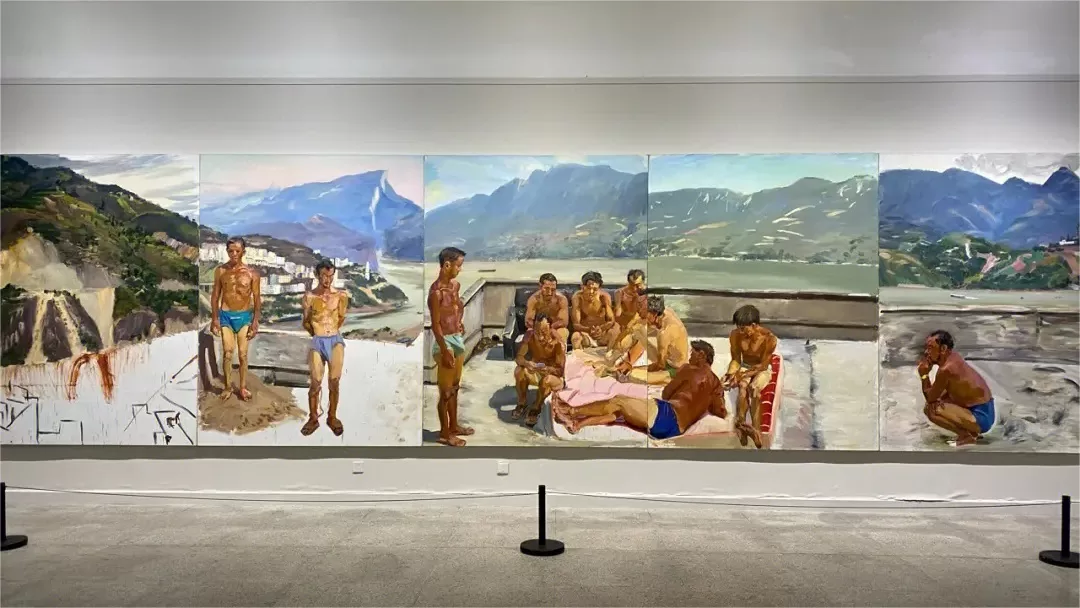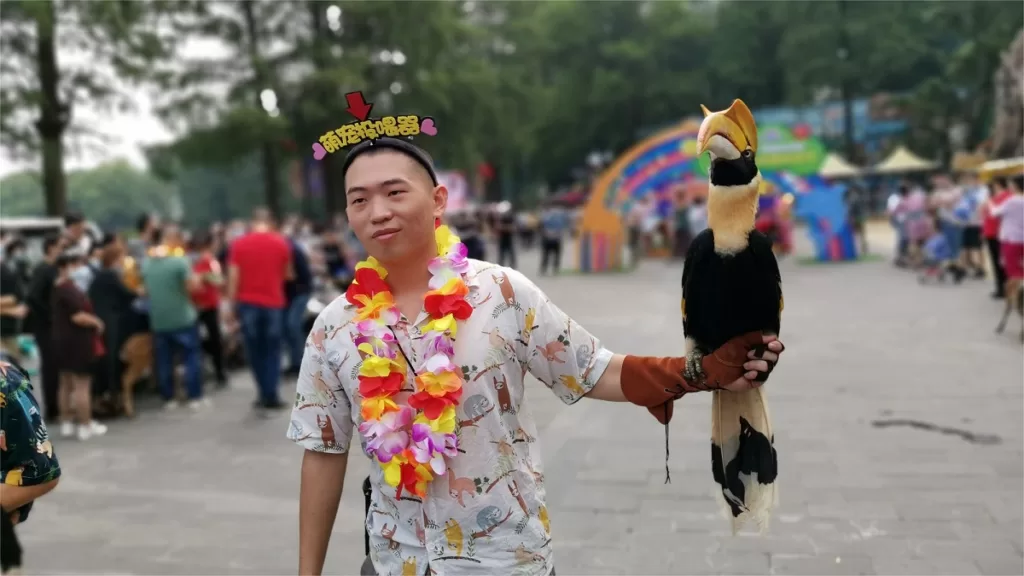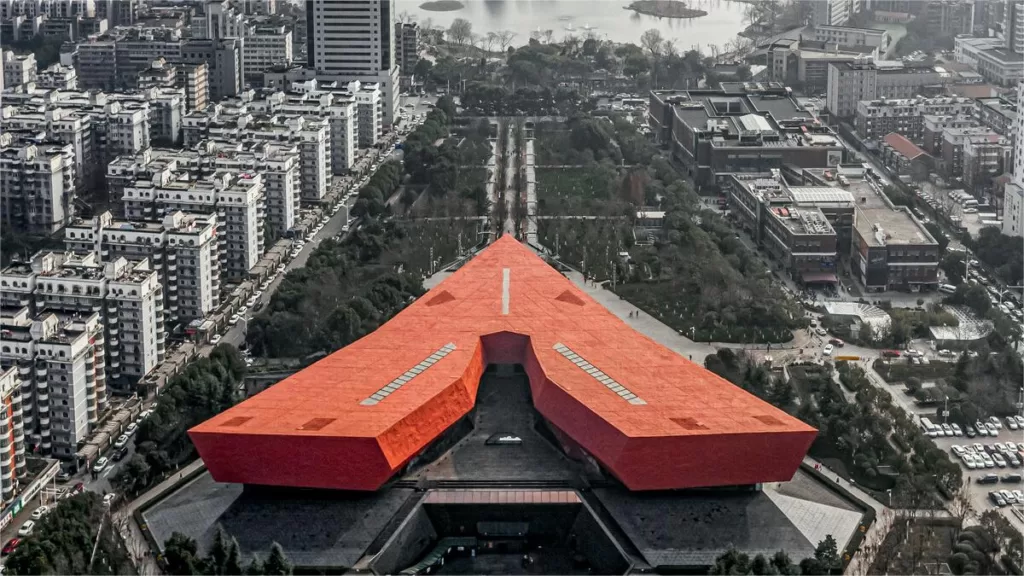The Hubei Museum of Art (湖北美术馆), located on the banks of East Lake in the Wuchang District of Wuhan, covers an expansive area of 15,318 square meters. The main building boasts four above-ground floors and one underground level, housing a total of 10 exhibition halls, along with a special exhibition hall and an audio-visual exhibition hall, with a combined exhibition space of approximately 7,000 square meters. The museum’s collection consists of a diverse range of 981 art pieces, encompassing Chinese traditional painting, oil painting, printmaking, sculpture, calligraphy and seal carving, photography, film and video art, installations, comic books, and lacquer painting, among others.
The primary architectural design of the Hubei Museum of Art harmoniously combines elements of square and circular shapes, straight lines and curves, creating a sleek and modern structure. Its exterior appearance, reminiscent of a drum, flute, and harp, carries connotations of local culture, contemporary design, architectural ecology, and spatial richness, evoking a sense of boundless anticipation and imagination about art.
Beyond its exhibition spaces, the museum features state-of-the-art support facilities, including a multi-functional academic lecture hall, a VIP lounge, an art training center, a cinema, both Chinese and Western restaurants, and a café, ensuring visitors have a comprehensive and enriching experience.
Table of Contents
- Basic Information
- Location and Transportation
- Exhibitions of Hubei Museum of Art
- Vlog about Hubei Museum of Art
- Attractions near Hubei Museum of Art
- Other Museums in Wuhan
Basic Information
| Website | http://wlt.hubei.gov.cn/ |
| Estimated Length of Tour | 3 hours |
| Ticket Price | Free |
| Opening Hours | 9.00 – 17.00; Last admission: 16.30 |
| Telephone Number | 0086-027-86796067 0086-027-86796062 |
Location and Transportation
The Hubei Museum of Art is situated at 1 Sanguandian, Donghu Road, Wuchang District, Wuhan City, Hubei Province, on the picturesque shores of East Lake. To get there, you can choose the following ways:
Bus: Take bus 402, 411, 709, or 810, and get off at Donghu Road Provincial Museum Stop (东湖路省博物馆站).
Metro: The closest metro station to Hubei Museum of Art is Provincial Museum Hubei Daily on line 8. After getting out of the station, you will be standing right at the entrance.
Exhibitions of Hubei Museum of Art
Art during the Republican Era (1911-1949)

The Republican Era marked a significant cultural transformation in Hubei’s art scene. Fueled by the May Fourth Movement, the province witnessed a surge in art societies, vibrant art exhibitions, and increased regional art exchanges. The establishment of modern art education, such as the “Wuchang School of Art,” played a crucial role in the systematization of art education in Hubei. The vigorous Wuhan Anti-Japanese War Art Movement brought together artists and literary figures from all over China, making Wuhan a focal point of the national anti-war and anti-Japanese propaganda campaign. This era was marked by the convergence of diverse artistic influences and the flourishing of art activities.
Art in New China (1949-1978)

During the early years of the People’s Republic of China, the art organizational framework was progressively developed and formalized. Art became an integral part of the proletarian revolutionary cause, guided by the principle of “serving the workers, peasants, and soldiers, and serving the proletarian politics.” In the 1950s and 1960s, under the directive of the “Let a Hundred Flowers Bloom and a Hundred Schools of Thought Contend” policy and the support of the government, various art exhibitions and creative activities thrived, leading to the creation of outstanding artworks reflecting the distinct characteristics of the era. Examples include “Steel Workers’ Printmaking” and “Huangpi Farmers’ Clay Sculpture.”
Art in the New Period (1979-2000)

In the new era, the liberation of thought became an irresistible historical trend. In a relatively relaxed and open cultural environment, the Hubei Museum of Art underwent a significant transformation compared to its previous incarnations. Artistic themes diversified, with bold innovations and the emergence of mature art styles. This period also witnessed a surge in theoretical research. Concurrently, as the thought liberation movement deepened, “New Wave Art” in Hubei emerged and gained strong momentum.












Exhibition Viewing Order: Visitors can choose the order based on their preferences, as the exhibitions on the first to fourth floors vary depending on recent installations. The first floor features cultural and creative shops and a cozy cafe for relaxing. The third floor offers a reading room for visitors to browse through materials, creating a very comfortable environment.